Bank Collapse Aftermath: Road to Market Riches Now Paved with Gold?

After last week's stock market blow-up, I'm reminded of "Hill Street Blues" - a favorite TV cop show of mine from my 1970s childhood.
The cops patrolled the gritty streets of a nameless, rundown northern city with all the usual problems and mayhem.
And at the start of every episode, the street-wise sergeant would gather everyone together in the squad room, give them a rundown of what was happening, and send them out on the streets with the warning:

"Hey, let's be careful out there."
For us, the reason to be careful...is volatility could pick up in both directions in a way that's confusing for bulls and bears.
And it could open up an opportunity for a long-overlooked group of stocks - gold mining companies - to do better than they've done for years (more on that below).
In the short-term, we need to be careful because there are lots of crosscurrents out there:
- Consumer Price Index (CPI) data is due out this Tuesday.
- The Federal Open Markets Committee (FOMC), i.e. the Fed, announces its latest decision on interest rates on Wednesday afternoon.
- The collapse of Silicon Valley Bank (SIVB): Over the weekend, the Treasury Department indicated that depositors will get their money back, but will let the bank itself fail.
- US Employment Report (for February): The latest US employment report came out last Friday, and showed that the US economy is still strong (which is good and bad for all the obvious reasons to investors).
You can see where I'm going with this...
There are opportunities for volcanic market eruptions. Maybe Tuesday's CPI report comes in more benign than expected, or the Fed surprises the markets in a positive way, as 2 potential possibilities.
Yet any sharp rebound could be met with yet more intense selling pressure. There's a rising level of economic uncertainty. Wall Street hates uncertainty; the default mode is to keep selling and reduce exposure to the market.
Heightened "Uncertainty"
That's why the collapse of Silicon Valley Bank last week could be very important.
We won't really know for sure except with the fullness of time. But for the first time since 2008, the collapse of a bank has really rattled Wall Street.
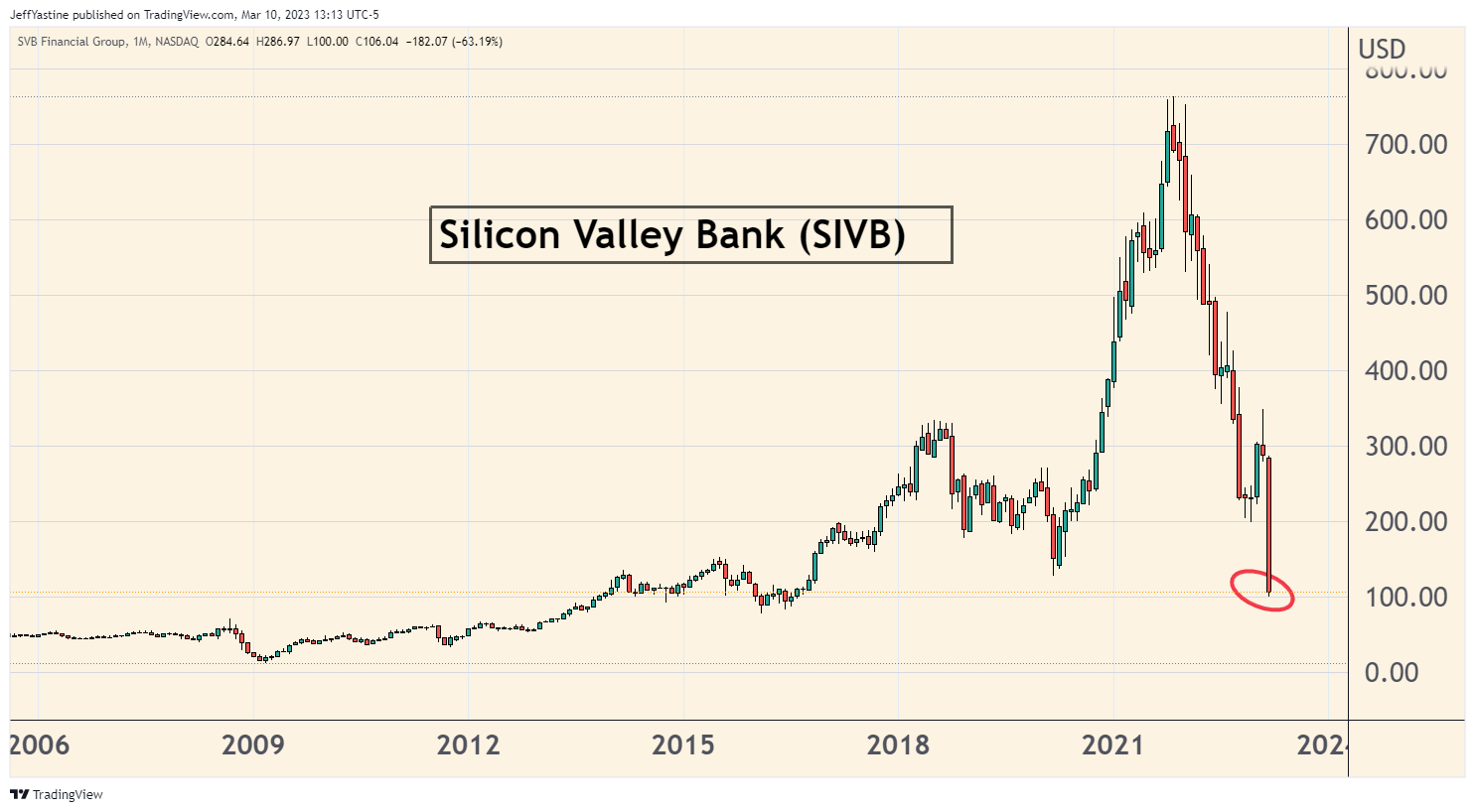
Until last week, most people didn't even know about Silicon Valley Bank. By size, it's the 18th largest in the country, which is big but not that big.
Yet its failure sent shock waves far and wide across the entire banking sector.
For example, the stock prices of regional banks - geographically and operationally remote from Silicon Valley and the tech sector - took a big tumble:
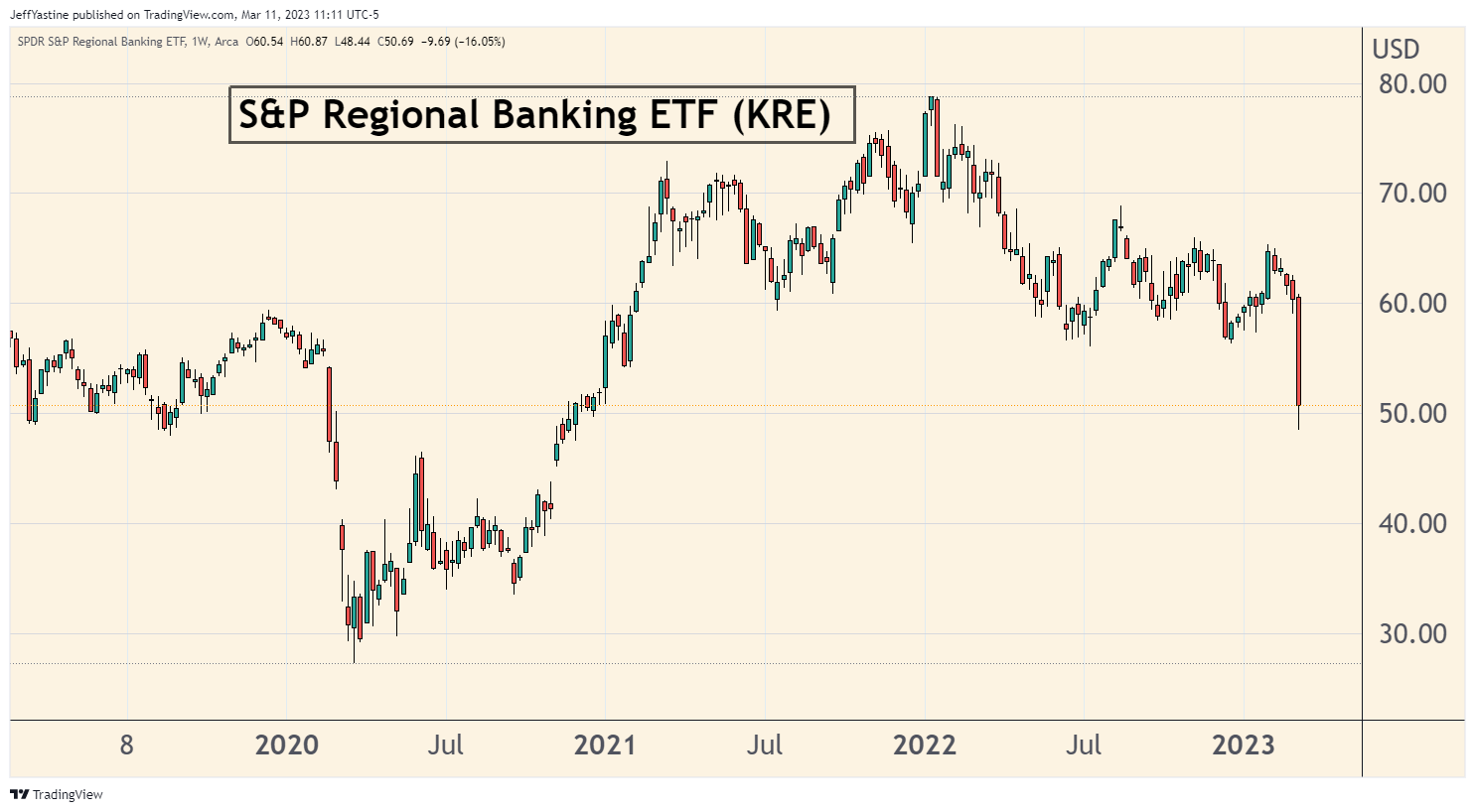
And so did the share prices of even the largest banks, such as Bank of America (BAC):
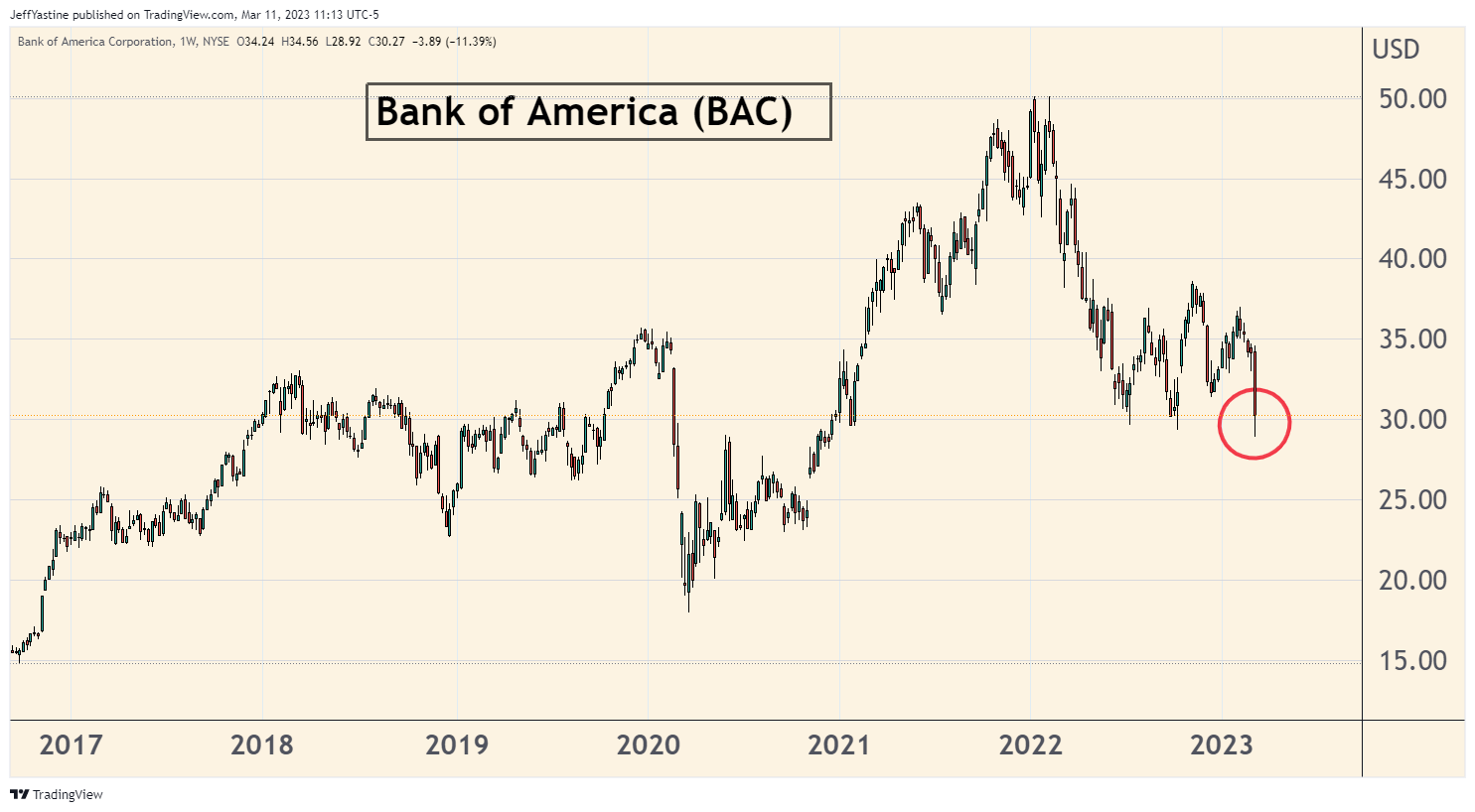
So that's another reason we "need to be careful out there"...
These kinds of events are sometimes like icebergs or landmines. We glimpse a little on the surface. But the dangerous stuff is impossible to see.... and therefore easy to dismiss.
Coming Soon to a Bank Near You?
The key part of last week's collapse is that Silicon Valley Bank owned huge amounts of US Treasury bonds as part of its financial reserves.
There's nothing wrong with that. As those Treasury bonds reach maturity, the bank gets its money back along with the interest it collected.
The problem is two-fold...
Problem #1: Interest rates and bond prices move in opposite directions.
In other words, as interest rates rose to 15-year highs over the past year or so, it drastically reduced the market value of older, lower-yielding Treasuries that were issued during the pandemic and the years prior.
Problem #2: All banks, per regulations, must periodically re-value their reserves in a process called "marking to market."
In other words, banks have to note the value of their assets based on the price they can get for them today - not years from now when their bond portfolios mature.
Silicon Valley Bank was forced to "mark to market" the price of its Treasury bond portfolio. But the reduced market value of those bonds, along with the downturn affecting its tech startup customers - created a big hole in its asset base.
Once that became generally known, the bank was toast.
So that's the "landmine" or "iceberg" aspect of last week's news - the important stuff for the rest of us....
Thousands of banks own Treasury bonds as part of their asset base. I'm sure (or let's say hopeful) that most of them made the appropriate portfolio adjustments with interest rate hedges or so-called "swaps agreements" to avoid a similar fate as Silicon Valley Bank.
But as Warren Buffett once quipped:
It's only when the tide goes out that you get to see who's swimming naked.
Human nature being what it is, it's possible that there are other banks out there that went for a years-long swim in the Treasury market, not anticipating a day when the Federal Reserve might decide to drain the pool.
That's the kind of uncertainty Wall Street hates the most, and can lead to deeper market declines if we're not careful.
Got Gold?
Inevitably, these kinds of events lead to speculation that the Federal Reserve will ride to the rescue, by indicating it will no longer raise rates, and perhaps start lowering them in the near future.
I think it could happen, and it sounds like the folks who trade this stuff professionally think it's likely as well. Here's a headline from Bloomberg on Friday:

I don't see it happening next week but perhaps in coming quarters (alongside more damage from the ongoing bear market).
For the Fed to switch sides, it depends on whether other large banks indicate a danger of collapse, how widespread (or not) the damage to the economy, and the depth of a continued selloff in the shares of bank stocks.
A Federal Reserve policy change would be greeted with cheers on Wall Street and result in a very big rally, no doubt.
But I don't believe it would set off a long-lasting bull market in the largest tech stocks and blue chip companies.
- The valuations of many stocks are still too high.
- Most consumers are too heavily indebted.
- Investors have long memories and - once burned by a stock that falls 60-90% in value - will typically avoid it.
But I believe it could set off a strong bull market in gold, and in particular - gold mining stocks.
Every asset has its day in the sun. Everything moves in cycles. The last time gold stocks were truly hot stuff was more than a decade ago, in 2012:
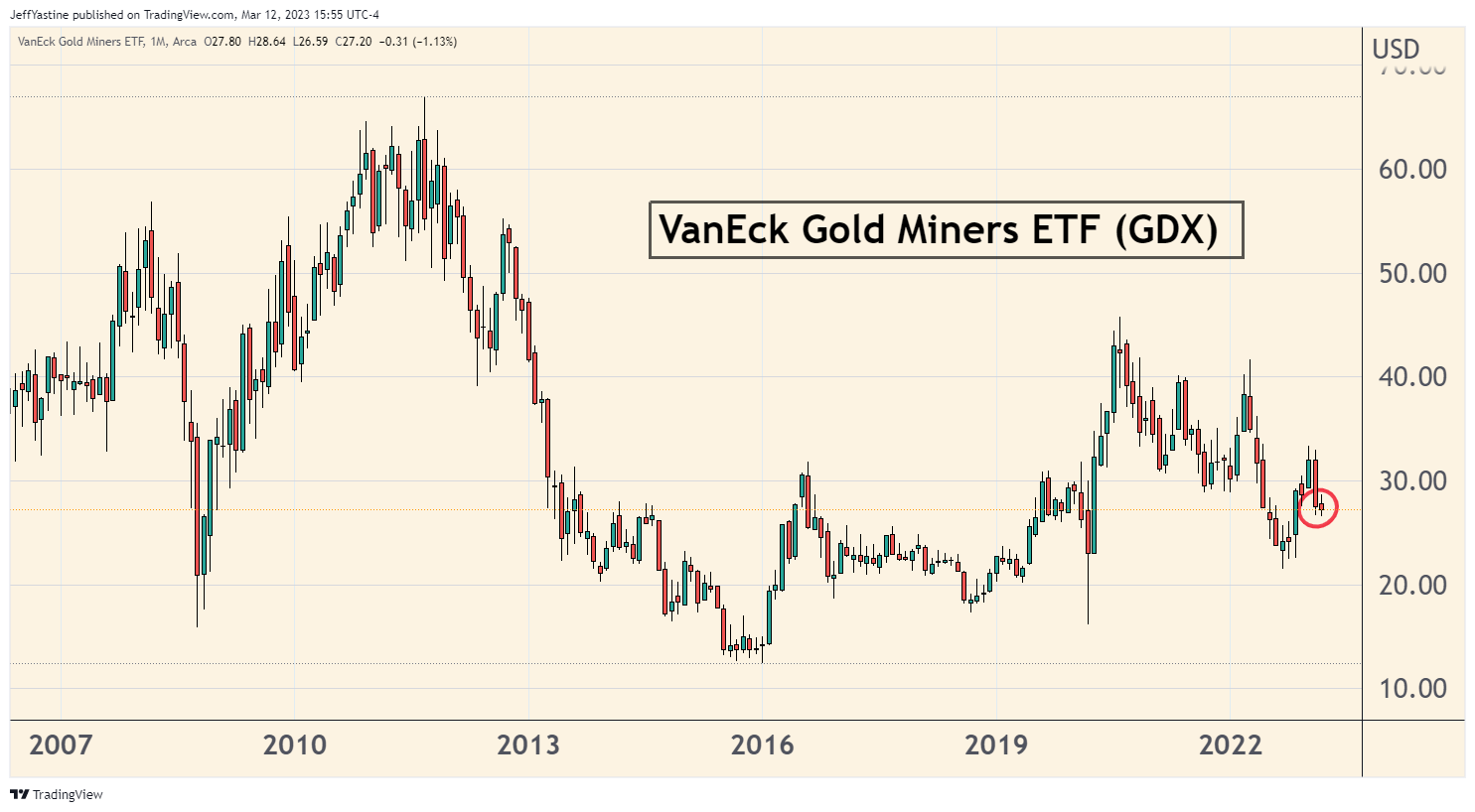
Small gold mining stocks - "juniors" in the language of gold stock buffs - have long since been cast off and forgotten by most investors as well:
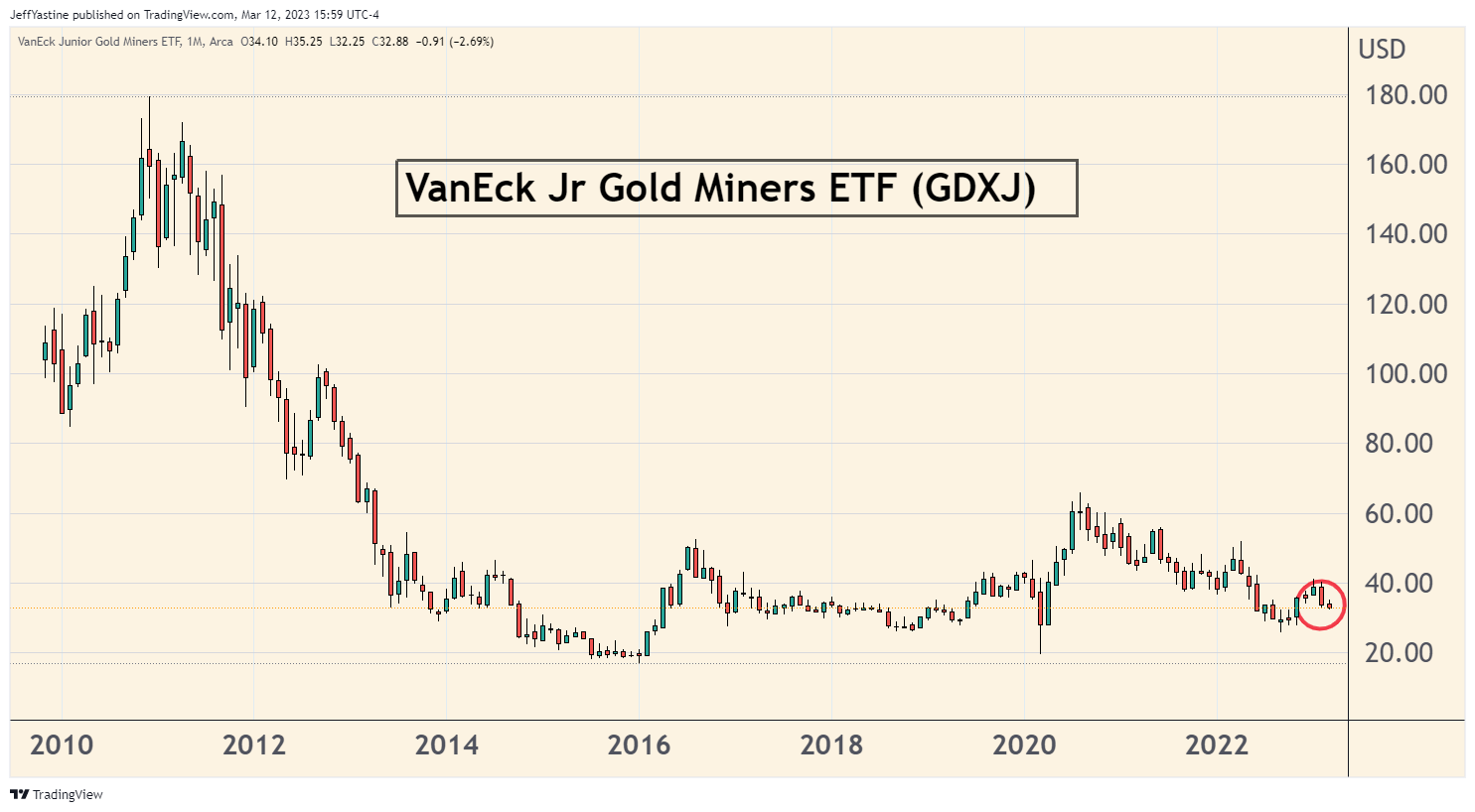
As an asset, gold ought to do very well in a future environment where the Fed is lowering rates to goose an already "over-goosed" economy.
Alongside that, we have a federal government running large debts, and paying increasingly higher interest on those debts. Depending on who's doing the statistics, interest on the federal debt is above $300 billion annually - and amounts to between 7-12% of federal spending.
And then there's the big question mark over whether Congress will raise the debt ceiling again - or let the government default on its debts.
Meanwhile, gold stocks have spent more than a decade wandering in the stock market wilderness. Most are trading at very low valuations, with small exploration budgets and minimal interest from outside investors.
In that time, crypto- and tech-stock trading have both come and gone. Real-estate values may yet go in the same direction.
That makes gold stocks an asset category worth closely watching in the weeks and months to come.
Best of goodBUYs,
Jeff Yastine
Member discussion